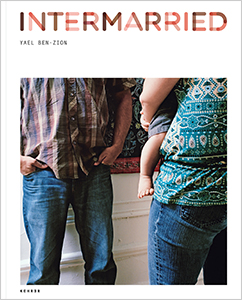INTERMARRIED (Kehrer, 2013) combines images and text. Some of it informative, most of it culled from a questionnaire I asked my subjects to fill out. In doing so, I wanted to put my subjects’ personal experiences within a wider social and political context.
The project also juxtaposes interfaith and interracial marriages although these relationships involve different sets of issues and may touch upon the sensitivities of different communities. By presenting them side-by-side I wish to stress the human aspects of the subject and to foster a dialogue about diversity, faith, acceptance and choice.
Selected images and texts follow. For more images see Intermarried
Murphy Bed
To make any relationship work, you have to figure out how to make all your differences work well together and race, to me, is just one small part of that whole puzzle…
—Daria
The term “mixed” is strictly an outsider observation. It is a term that “others” would use to define what their eyes see. All couples, gay, straight, summer/winter … all get reduced to common life themes: time with each other, money, sex, children. All relationships are destined to become ordinary.Most people in “same/same” relationships would be surprised at how quickly “different” disappears and you become just two people trying to sustain friendship& happiness.
—Cedric
For New York City, where one-half of the total Jewish population of the United States is concentrated, the intermarriage ratio, according to the data gathered for this study, is less than 2% (1.17). …
Just as difference of religion explains adequately the low proportion of intermarriage betweens Jews and non-Jews, so difference of color accounts for the small proportion of fusion between negro and white. … In New York City, for a period of five years (1908-1912) the ratio was 1.08%.
—Julius Drachsler, Intermarriage in New York City: A Statistical Study of the Amalgamation of European Peoples, 49-50 (1921)
Frames
Beatrice Rippy married Carroll Hollister in New York in 1959, one year after Mildred and Richard Loving got married in Washington, D.C. to avoid the anti-miscegenation statutes of their home state, Virginia.
New York is one of the nine states in the US that never enacted anti-miscegenation laws.
West Side Story
Jeff is Catholic and I am Jewish – that difference has defined us mostly because of the impact our relationship had on our families, who were not supportive of our being together. Indeed, for me, our relationship cost for many years the family in which I grew up.
Jeff’s family was more passive in their approach to the relationship. When Jeff told them he wanted to marry me, they did not support it and expressed concern that they would have Jewish grandchildren. Unlike my mother and sister, they did attend our wedding.
The birth of our daughter, Annabel, in 2006, has helped the mothers overcome their feelings a bit (though issues flare up every now and then). The mothers met for the first time in the hospital when Annabel was born.
—Ilana
Zebras
The question of race was presented to us immediately upon our daughter’s birth. She was, and continues to be, very fair-skinned and will probably be able to pass for “white” throughout her life. After she was born, we declined to put down an answer for race on the paperwork, as this would impose an arbitrary racial identity that is not in keeping with the diversity of her racial heritage. As she grows older, it continues to be important to us that she understands and celebrates her Black and Puerto Rican heritage, regardless of how others might perceive her.
—Desiree and Cantwell

Kehrer Verlag
Hardcover | 24 x 29.5 cm
128 pages | 57 color ills
English